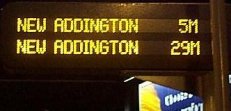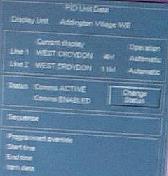|
||||||||||||
|
Home | ||||||||||||
  
|
|
|
|
Passenger Information Displays (PIDs) |
|
Each platform has a Passenger Information Display or PID. These are commonly known as Next Tram displays and are caberble of displaying two lines of text. Usually, they show the next two trams destination and the time before their arrival. |
| How the PID Works |
|
The PIDs work on a combination of actual and predicted (i.e. timetable) journeys. The timetable is held on the central computer and timetabled departure times are sent out to the terminal tramstops. The PID then displays these timetabled departure times. The tramstops along the line show increasing times to arrival of the next tram based on the travel time from the terminal tramstop (or reporting point - see below). Thus if a tram is timetabled to depart Wimbledon in 10 minutes, the next tram at Dundonald Road will be in 11 minutes and the next tram at Merton Park will be in 13 minutes etc. down the line. The times will count down until the minimum - i.e. 1 minute at Wimbledon, 2 minutes at Dundonald Road and 4 minutes at Merton Park on the assumption that the timetabled trip will operate. If for some reason the timetabled trip is not going to run, the control room operator needs to delete the trip from the timetable otherwise the trip will remain showing for the rest of the day. Say the first trip of the day from Wimbledon is due to leave at 0800. The time will count down until 1 minute to departure is shown and then it will stay there. The PID (and the central timetable) will expect the trip to run. The PID will be updated on actual tram journeys as well, so if the trip is not cancelled it will continue to show the scheduled trip plus any actual trips. If a "Not In Service" tram runs up to Wimbledon and back the PIDs will change to show the next tram as "Not In Service" (or "See Front of Tram" if the tram has a valid set number but is running as unscheduled) and the time to arrival will be based on the previous tram stop. For instance the PID at Wellesley Road will show the expected (timetabled) arrivals. But as soon as a tram arrives at West Croydon the PID will change to show the actual destination of the next tram and count down accordingly. How this works in practice, especially round the loop and at East Croydon, remains to be seen. |
|
|
| Problems |
|
It is always difficult to get the balance right about what information to show. When the service is half hourly, it's possible the second tram to arrive has still to start its return (say, eastbound) journey when its next westbound journey is already showing on the PIDs. As the control room operators become more adept at managing the timetable the accuracy of the PIDs will improve. Certainly recently the PIDs have been showing pretty accurate information. Another example. The next westbound tram at Therapia Lane was showing 24 minutes, whereas the next tram at Mitcham Junction was showing 8 minutes. (The running time between Therapia Lane and Mitcham Junction is not 16 minutes!). This was because an earlier trip departing the depot at the Beddington Lane end had not operated and had not been cancelled. Therefore the PID at Mitcham Junction was still expecting it, whereas the PID at Therapia Lane was showing the genuine next tram. Another traip that had not been deleted was one that was due to reverse at Beddington Lane and then go to Beckenham Junction. Thus the eastbound PID at, say, Waddon Marsh, was showing the next tram as being for Beckenham Junction in 3 minutes. This was because a) the trip to Beckenham Junction had not been deleted from the timetable and b) the PID based its time to arrival on the closest reporting point up the line - in this case Therapia Lane (rather than the starting point of Beddington Lane). |
| Confused? |
|
I'm not surprised as it takes some working out, but if you think about it, the system is logical and it is possible to work out what is going on on the PIDs once you know how the system works. The basic conclusion if trams arrive at times different from what is howing on the PID is that the control room operators have missed deleting a trip. A problem with the timetable management is that if all preceding trips (for a particular tram - or set number) are not cancelled the system will show the time to arrival based on the next scheduled ("pending") trip. Unfortunately having the system automatically delete missed trips is not necessarily a good idea because if the while service is running late, who is to say at what stage trips should be deleted automatically. The whole system could run two hours late but so long as the trips are operated the PIDs will respond accordingly. |
| In the Control Room |
|
They have been used in the past to warn off vandals by direct messages such as "Stop putting stones on the track - You are being recorded on CCTV".
Thanks to a correspondent for much of the information on this page. |
|
|
| Designed by Trapdoor Internet Services |

 Controllers
are able to control exactly what each line of each PID displays. Usually,
it is left to show the next two trams and on automatic and they don't
have to worry about them. However, lines on the PID at individual, or
at any grouping of stops can be changed to display messages on delays
or service interruptions.
Controllers
are able to control exactly what each line of each PID displays. Usually,
it is left to show the next two trams and on automatic and they don't
have to worry about them. However, lines on the PID at individual, or
at any grouping of stops can be changed to display messages on delays
or service interruptions.